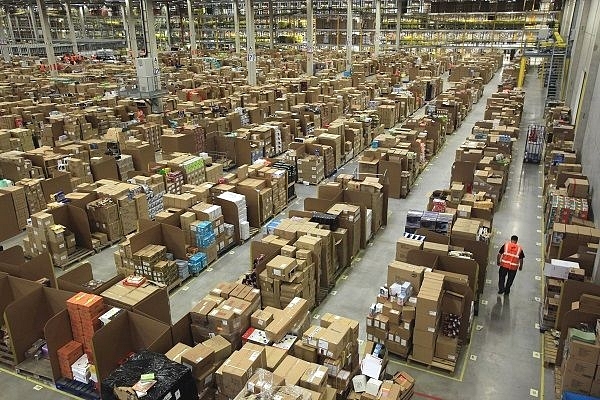Business
India's E-commerce Market Is Expected To Reach $120 Billion By 2025: Report
- As per a London-based data and analytics firm, e-commerce sales in India will expand at a compound annual growth rate of over 18 per cent to reach $120.1 billion by 2025.

Warehouse for an e-commerce firm. (representative image) (Matt Cardy/Getty Images)
India's e-commerce growth slowed dramatically in 2020, but the estimation for this year, as well as forecasts through 2022, suggest a strong increase before levelling off in 2025. According to research from GlobalData, a London-based data and analytics firm, e-commerce sales will expand at a compound annual growth rate (CAGR) of just over 18 per cent to reach $120.1 billion (8.8 trillion in Indian rupees) between 2021 and 2025.
The e-commerce channel is now on an accelerating upward trajectory, according to card payment values and GlobalData's e-commerce analytics reported Forbes. Between 2017 and 2020, annual growth rates dropped from about 30 per cent to just over 12 per cent last year. This year, the tendency will be upwards again, to around 17 per cent, taking the market past $60 billion and then over 20 per cent by 2022. This is occurring at a time when overall consumer spending is dropping, and the economy is slowing. As per the report, the rebound that is taking place may reflect the significant impact that the Covid-19 pandemic is having in India this year compared to 2020—when the infection wave was long, but the impact was low, while this year daily cases exceeded 400,000 at the peak in May.
After the pandemic hit India in 2020, the government embraced a guarded approach to ensure the safety of the citizens and that included closing crowded and public places. At that time, many consumers also adopted a new behaviour—placing online orders. Ravi Sharma, banking and payments lead analyst at GlobalData said: "The Covid-19 pandemic fast-tracked consumers' transition to digital payments in most markets, a trend also seen in India. With social distancing rules and the closure of many brick and mortar stores, shoppers have embraced online channels even for their day-to-day purchases".
The e-commerce future in India is bright, thanks to rising smartphone penetration—from 42 per cent currently to 51 per cent by 2025—as well as increasing digital literacy among customers and the government's digital push. There has been a significant increase in the number of online shoppers in Tier 2 and 3 cities in recent years, owing to improved internet penetration, increased awareness of e-commerce, and the adoption of cashless payments.
According to a Unicommerce e-commerce trends report from 2020, over two-thirds of India's online consumer demand comes from Tier 2 and lower cities. As travel restrictions due to the pandemic waves continue to affect industries such as travel and housing adversely, online purchases of retail goods such as groceries, electronics and healthcare, have increased significantly, said the Forbes report.
Payment Mode
GlobalData's analysis highlighted that the key players of the e-commerce market, such as Flipkart, Amazon and BigBasket, have noticed a rise in orders each month since the pandemic started. Even to help grow their consumer base, these companies expanded their digital payment choices.
For example, Flipkart, which has 300 million registered customers, implemented QR code-based payment method for pay-on-delivery shipments to allow customers to make digital payments at the time of delivery from any UPI application. Ranjith Boyanapalli, who is Flipkart's head of fintech and payments group said: "With pay-on-delivery technology, customers have peace of mind with their payments and at the same time can shop within the safety of their homes".
In that case, the pay later option is also becoming more popular in India—such as Amazon Pay Later, which now has two million users. This payment alternative was launched in April 2020, and it allows customers to shop, as well as pay in monthly instalments. Other companies that provide similar payment services include ePayLater and LazyPay. GlobalData's Sharma said that the global health crisis has expedited India's migration to digital payments, bringing e-commerce to a whole new class of consumers and merchants who had never used it before. He added that "a rising consumer preference for online shopping, the proliferation of e-retailers and the emergence of new payment methods will continue to drive the growth".
However, according to Unicommerce, most of India's e-commerce growth is coming from "the hinterland of India," or areas outside of the country's major cities. Young Indian customers in smaller cities are driving the most growth, with Tier 3 and beyond cities leading the way.
Even though GlobalData's report showed a promising future, according to the Indo-American Chamber of Commerce (IACC), planned revisions to the Consumer Protection (E-Commerce) Rules, 2020, which are intended to protect consumer interests, may exacerbate the impact of a plethora of restrictions on the e-commerce sector. IACC, which is the premier bilateral chamber for Indo-US business, told the Indian government that the proposed revisions would increase compliance obligations, potentially stifling the sector's growth.
As per a report by Business Standard, IACC national vice president Dr Lalit Bhasin in a letter (dated 2 July 2021) addressed to Anupam Mishra, Joint Secretary, Department of Consumer Affairs Ministry said: "We also draw your attention to the fact that such a measure will affect investor sentiment globally, especially with respect to 'Ease of Doing Business' in the country".
Introducing ElectionsHQ + 50 Ground Reports Project
The 2024 elections might seem easy to guess, but there are some important questions that shouldn't be missed.
Do freebies still sway voters? Do people prioritise infrastructure when voting? How will Punjab vote?
The answers to these questions provide great insights into where we, as a country, are headed in the years to come.
Swarajya is starting a project with an aim to do 50 solid ground stories and a smart commentary service on WhatsApp, a one-of-a-kind. We'd love your support during this election season.
Click below to contribute.
Latest